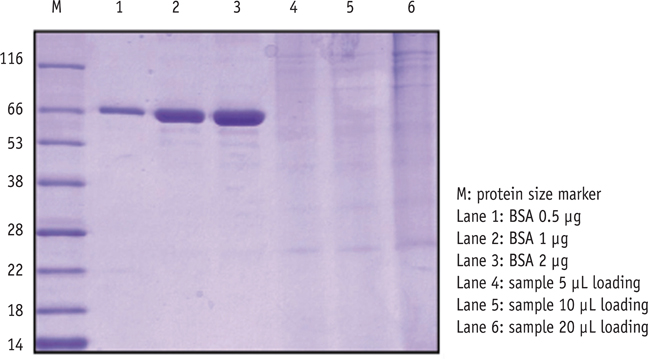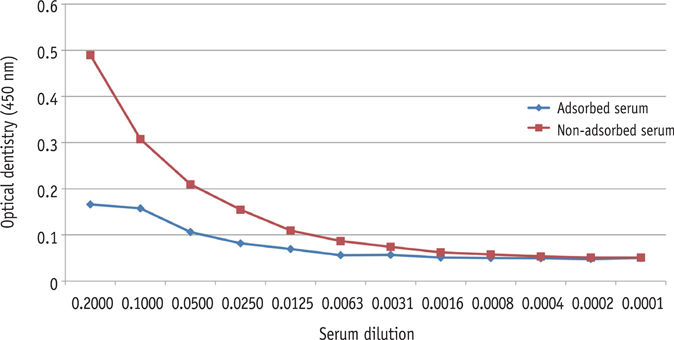Restor Dent Endod.
2015 Nov;40(4):306-311. 10.5395/rde.2015.40.4.306.
Identification of Enterococcus faecalis antigens specifically expressed in vivo
- Affiliations
-
- 1Department of Dental Education, Dental Science Research Institute and BK21 Project, School of Dentistry, Gwangju, Korea. swlee@jnu.ac.kr
- 2Department of Periodontology, Dental Science Research Institute and BK21 Project, School of Dentistry, Gwangju, Korea.
- 3Department of Maxillofacial Surgery, Dental Science Research Institute and BK21 Project, School of Dentistry, Gwangju, Korea.
- 4Department of Prosthodontics, Dental Science Research Institute and BK21 Project, School of Dentistry, Gwangju, Korea.
- 5Department of Veterinary Medicine, Chonnam National University, Gwangju, Korea.
- KMID: 2316951
- DOI: http://doi.org/10.5395/rde.2015.40.4.306
Abstract
OBJECTIVES
Molecular mechanism of the pathogenicity of Enterococcus faecalis (E. faecalis), a suspected endodontic pathogen, has not yet been adequately elucidated due to limited information on its virulence factors. Here we report the identification of in vivo expressed antigens of E. faecalis by using a novel immunoscreening technique called change-mediated antigen technology (CMAT) and an experimental animal model of endodontic infection.
MATERIALS AND METHODS
Among 4,500 E. coli recombinant clones screened, 19 positive clones reacted reproducibly with hyperimmune sera obtained from rabbits immunized with E. faecalis cells isolated from an experimental endodontic infection. DNA sequences from 16 of these in vivo-induced (IVI) genes were determined.
RESULTS
Identified protein antigens of E. faecalis included enzymes involved in housekeeping functions, copper resistance protein, putative outer membrane proteins, and proteins of unknown function.
CONCLUSIONS
In vivo expressed antigens of E. faecalis could be identified by using a novel immune-screening technique CMAT and an experimental animal model of endodontic infection. Detailed analysis of these IVI genes will lead to a better understanding of the molecular mechanisms involved in the endodontic infection of E. faecalis.
Keyword
MeSH Terms
Figure
Reference
-
1. Finlay BB, Falkow S. Common themes in microbial pathogenicity revisited. Microbiol Mol Biol Rev. 1997; 61:136–169.
Article2. Falkow S. Molecular Koch's postulates applied to microbial pathogenicity. Rev Infect Dis. 1988; 10:Suppl 2. S274–S276.
Article3. Sundqvist G, Johansson E, Sjögren U. Prevalence of black-pigmented bacteroides species in root canal infections. J Endod. 1989; 15:13–19.
Article4. Griffee MB, Patterson SS, Miller CH, Kafrawy AH, Newton CW. The relationship of Bacteroides melaninogenicus to symptoms associated with pulpal necrosis. Oral Surg Oral Med Oral Pathol. 1980; 50:457–461.
Article5. Sundqvist GK, Eckerbom MI, Larsson AP, Sjögren UT. Capacity of anaerobic bacteria from necrotic dental pulps to induce purulent infections. Infect Immun. 1979; 25:685–693.
Article6. Sundqvist G, Figdor D, Persson S, Sjögren U. Microbiologic analysis of teeth with failed endodontic treatment and the outcome of conservative retreatment. Oral Surg Oral Med Oral Pathol Oral Radiol Endod. 1998; 85:86–93.
Article7. Hancock HH 3rd, Sigurdsson A, Trope M, Moiseiwitsch J. Bacteria isolated after unsuccessful endodontic treatment in a North American population. Oral Surg Oral Med Oral Pathol Oral Radiol Endod. 2001; 91:579–586.
Article8. Kayaoglu G, Ørstavik D. Virulence factors of Enterococcus faecalis: relationship to endodontic disease. Crit Rev Oral Biol Med. 2004; 15:308–320.
Article9. Smith H. Questions about the behaviour of bacterial pathogens in vivo. Philos Trans R Soc Lond B Biol Sci. 2000; 355:551–564.10. Angelichio MJ, Camilli A. In vivo expression technology. Infect Immun. 2002; 70:6518–6523.11. Mahan MJ, Slauch JM, Hanna PC, Camilli A, Tobias JW, Waldor MK, Mekalanos JJ. Selection for bacterial genes that are specifically induced in host tissues: the hunt for virulence factors. Infect Agents Dis. 1993; 2:263–268.12. Hensel M, Shea JE, Gleeson C, Jones MD, Dalton E, Holden DW. Simultaneous identification of bacterial virulence genes by negative selection. Science. 1995; 269:400–403.
Article13. Valdivia RH, Falkow S. Fluorescence-based isolation of bacterial genes expressed within host cells. Science. 1997; 277:2007–2011.
Article14. Ramachandran N, Raphael JV, Hainsworth E, Demirkan G, Fuentes MG, Rolfs A, Hu Y, LaBaer J. Next-generation high-density self-assembling functional protein arrays. Nat Methods. 2008; 5:535–538.
Article15. Rollins SM, Peppercorn A, Hang L, Hillman JD, Calderwood SB, Handfield M, Ryan ET. In vivo induced antigen technology (IVIAT). Cell Microbiol. 2005; 7:1–9.16. Handfield M, Hillman JD. In vivo induced antigen technology (IVIAT) and change mediated antigen technology (CMAT). Infect Disord Drug Targets. 2006; 6:327–334.
Article17. Lee SW, Hillman JD, Progulske-Fox A. The hemagglutinin genes hagB and hagC of Porphyromonas gingivalis are transcribed in vivo as shown by use of a new expression vector. Infect Immun. 1996; 64:4802–4810.
Article18. Yoo JY, Kim HC, Zhu W, Kim SM, Sabet M, Handfield M, Hillman J, Progulske-Fox A, Lee SW. Identification of Tannerella forsythia antigens specifically expressed in patients with periodontal disease. FEMS Microbiol Lett. 2007; 275:344–352.
Article19. Handfield M, Brady LJ, Progulske-Fox A, Hillman JD. IVIAT: a novel method to identify microbial genes expressed specifically during human infections. Trends Microbiol. 2000; 8:336–339.
Article20. Cheng S, Clancy CJ, Checkley MA, Handfield M, Hillman JD, Progulske-Fox A, Lewin AS, Fidel PL, Nguyen MH. Identification of Candida albicans genes induced during thrush offers insight into pathogenesis. Mol Microbiol. 2003; 48:1275–1288.
Article21. Hang L, John M, Asaduzzaman M, Bridges EA, Vanderspurt C, Kirn TJ, Taylor RK, Hillman JD, Progulske-Fox A, Handfield M, Ryan ET, Calderwood SB. Use of in vivo-induced antigen technology (IVIAT) to identify genes uniquely expressed during human infection with Vibrio cholerae. Proc Natl Acad Sci U S A. 2003; 100:8508–8513.
Article22. Deb DK, Dahiya P, Srivastava KK, Srivastava R, Srivastava BS. Selective identification of new therapeutic targets of Mycobacterium tuberculosis by IVIAT approach. Tuberculosis (Edinb). 2002; 82:175–182.
Article23. Kim YR, Lee SE, Kim CM, Kim SY, Shin EK, Shin DH, Chung SS, Choy HE, Progulske-Fox A, Hillman JD, Handfield M, Rhee JH. Characterization and pathogenic significance of Vibrio vulnificus antigens preferentially expressed in septicemic patients. Infect Immun. 2003; 71:5461–5471.
Article24. John M, Kudva IT, Griffin RW, Dodson AW, McManus B, Krastins B, Sarracino D, Progulske-Fox A, Hillman JD, Handfield M, Tarr PI, Calderwood SB. Use of in vivo-induced antigen technology for identification of Escherichia coli O157:H7 proteins expressed during human infection. Infect Immun. 2005; 73:2665–2679.
Article25. Harris JB, Baresch-Bernal A, Rollins SM, Alam A, LaRocque RC, Bikowski M, Peppercorn AF, Handfield M, Hillman JD, Qadri F, Calderwood SB, Hohmann E, Breiman RF, Brooks WA, Ryan ET. Identification of in vivo-induced bacterial protein antigens during human infection with Salmonella enterica serovar Typhi. Infect Immun. 2006; 74:5161–5168.
Article26. Salim KY, Cvitkovitch DG, Chang P, Bast DJ, Handfield M, Hillman JD, de Azavedo JC. Identification of group A Streptococcus antigenic determinants upregulated in vivo. Infect Immun. 2005; 73:6026–6038.
Article27. Cao SL, Progulske-Fox A, Hillman JD, Handfield M. in vivo induced antigenic determinants of Actinobacillus actinomycetemcomitans. FEMS Microbiol Lett. 2004; 237:97–103.
Article28. Song YH, Kozarov EV, Walters SM, Cao SL, Handfield M, Hillman JD, Progulske-Fox A. Genes of periodontopathogens expressed during human disease. Ann Periodontol. 2002; 7:38–42.
Article29. Gu H, Zhu H, Lu C. Use of in vivo-induced antigen technology (IVIAT) for the identification of Streptococcus suis serotype 2 in vivo-induced bacterial protein antigens. BMC Microbiol. 2009; 9:201.
Article30. Lee HR, Rhyu IC, Kim HD, Jun HK, Min BM, Lee SH, Choi BK. In vivo-induced antigenic determinants of Fusobacterium nucleatum subsp. nucleatum. Mol Oral Microbiol. 2011; 26:164–172.
Article31. Savli H, Karadenizli A, Kolayli F, Gundes S, Ozbek U, Vahaboglu H. Expression stability of six housekeeping genes: A proposal for resistance gene quantification studies of Pseudomonas aeruginosa by real-time quantitative RT-PCR. J Med Microbiol. 2003; 52:403–408.
Article32. Vandecasteele SJ, Peetermans WE, Merckx R, Van Eldere J. Quantification of expression of Staphylococcus epidermidis housekeeping genes with Taqman quantitative PCR during in vitro growth and under different conditions. J Bacteriol. 2001; 183:7094–7101.
Article33. Widada J, Nojiri H, Kasuga K, Yoshida T, Habe H, Omori T. Quantification of the carbazole 1,9a-dioxygenase gene by real-time competitive PCR combined with coextraction of internal standards. FEMS Microbiol Lett. 2001; 202:51–57.
Article34. Espirito Santo C, Taudte N, Nies DH, Grass G. Contribution of copper ion resistance to survival of Escherichia coli on metallic copper surfaces. Appl Environ Microbiol. 2008; 74:977–986.
Article35. Grass G, Rensing C, Solioz M. Metallic copper as an antimicrobial surface. Appl Environ Microbiol. 2011; 77:1541–1547.
Article36. Walters S, Belanger M, Rodrigues PH, Whitlock J, Progulske-Fox A. A member of the peptidase M48 superfamily of Porphyromonas gingivalis is associated with virulence in vitro and in vivo. J Oral Microbiol. 2009; 1.37. Yuan L, Rodrigues PH, Bélanger M, Dunn W Jr, Progulske-Fox A. The Porphyromonas gingivalis clpB gene is involved in cellular invasion in vitro and virulence in vivo. FEMS Immunol Med Microbiol. 2007; 51:388–398.38. Yuan L, Rodrigues PH, Bélanger M, Dunn WA Jr, Progulske-Fox A. Porphyromonas gingivalis htrA is involved in cellular invasion and in vivo survival. Microbiology. 2008; 154:1161–1169.
Article
- Full Text Links
- Actions
-
Cited
- CITED
-
- Close
- Share
- Similar articles
-
- A Case of Bilateral Endogenous Enterococcus Faecalis Endophthalmitis in Liver Abscess
- Antimicrobial Resistance Pattern in Enterococcus faecalis Strains Isolated From Expressed Prostatic Secretions of Patients With Chronic Bacterial Prostatitis
- Recurrent Enterococcus faecalis Endophthalmitis
- Clinical Features and Rate of Infective Endocarditis in Non-Faecalis and Non-faecium Enterococcal Bacteremia
- Epidemiology and Molecular Characterization of Vancomycin-Resistant Enterococcus faecalis



